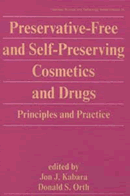Preservative-Free and Self-Preserving Cosmetics and Drugs: Principles and Practice,
edited by Jon J. Kabara and Donald S. Orth
reviewed 2005-02-25 by Elishalom Yechiel, Ph.D.

Preservative-Free and Self-Preserving Cosmetics and Drugs (Dekker, 1997) is a collection of essays all related to developing issues in cosmetic and drug preservation.The authors address a new trend in cosmetic products: formulations without harmful preservatives. Or do they?
The book provides good coverage of preservation aspects of different ingredients and provides pointers to the mechanistics of anti-microbial activity of different ingredients. Overall, the writing is clear, with natural connections between chapters written by different authors. The book is recommended for manufacturers concerned about pressure from consumer groups to avoid parabens and other well-established preservatives, or under the same pressure from companies offering new preservatives which compete with familiar ingredients. It may also be suitable for educated consumers with a basic scientific background.
The basic question of whether or why current preservation practices should be changed is not adequately elaborated upon in this book; terminology such as “self-preserving formula” may be useful in marketing, but has no scientific value.
The book provides a list of popular preservatives which are currently in use and discusses how to combine individual ingredients which have specific anti-bacterial activity but do not qualify as standalone preservatives to reach critical preservation power. The authors name products with such preservation types as “self-preserving products” and discuss practical methods of reaching cumulative preservation power in “self-preserving products”. The authors point out that such preservation must be confirmed for each product variation, and maybe for each batch. This could make products very expensive and inflexible, unable to accept even minor modifications, constraints more reminiscent of drug manufacturing than cosmetics manufacturing. The other suggestion, “contamination-resistant packaging”, is currently practical for single-use products made under sterile conditions.
One missing chapter in this book is the un-written chapter about post-application preservation, or maintaining preservation power while a product is on skin. Though the book mentions the fact that severe injury, including blindness, due to under-presevation has been reported and has raised the concern of regulatory bodies, there is no effort to address potential post-application under-preservation issues which are more likely in “self-preserving products” and in “contamination-resistant packaging” than in products preserved with standalone preservatives.
Self-preserving products are based on cumulative stress on microorganisms from individual bacterial-limiting aspects of certain ingredients. Cumulative stress is likely to be synergistic, and thus a non-linear effect. Even a slight dilution may render the cumulative “self-preservation” useless. Unlike food, which must be preserved until it is eaten, at which point the effectiveness of preservation is moot, topical formulations are meant to stay in contact with skin for 12-24 hours if used properly, and may be left on skin longer by consumers neglecting or ignoring label instructions. If a formulation is rich in natural nutrients and is left for an extended period on the skin and diluted by perspiration, it can provide a fertile ground for growth of microorganisms, either those already in the formula or new ones acquired from the skin or the environment. This issue of post-application contamination is critical, particularly in regard to natural products which are less likely to have adequate preservatives added during their formulation. Ironically, it is natural product consumers who are leading the anti-preservation campaign.
The other missing chapter in the book is a detailed discussion about why is it important to seek new methods of preservation. What is wrong with current preservatives? Other than a vague comment about irritation from some products containing preservatives, there is no real discussion. There is no suggestion of even the possibility that in many cases the irritation is related to the overall formula quality and not to the preservatives or any specific ingredient in the formula. They do not mention that, in some cases, people who were “irritated by a preservative” in one product could tolerate the same preservative in another product, which means that the problem is with the overall product and not necessarily with the preservative. Allergic reactions are mentioned. Some individuals can have allergic reactions to the mildest known ingredients; those individuals cannot and should not use those ingredients. Irritation is not the same as allergy; look for an in-depth discussion of this key distinction in a future article.
The book is an interesting snapshot of a difficult moment, with scientists increasingly interested in meeting consumer expectations and consumers increasingly aware of, and increasingly shaping, the processes of scientific inquiry and product development. The impossibililty of satisfying all parties here demonstrates how difficult it is to maintain a scientific aura while addressing a trend imposed by consumer demand. While the authors are careful not to be labeled as anti-preservationists, they are far more reluctant to take issue with the sensibility of this trend; they seem to be carefully clinging to their scientific integrity while avoiding clashes with potential customers.